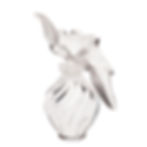A BRIEF HISTORY OF RENÉ LALIQUE AND LALIQUE CRISTAL
- Farhad Radfar
- Jan 31, 2017
- 3 min read

René Lalique (French, 1860-1945) was an incredibly diverse artist and craftsman as well as an astute businessman. His career began when he was apprenticed to the jeweler Louis Aucoc in Paris at the age of 16. After studying in France and England and working as a jewelry designer for several firms, Lalique eventually opened his own shop in Paris in 1890. It was while working on jewelry designs for his own shop that he began experimenting with glass and incorporating it into his pieces. By the 1890s, Lalique was incredibly well-known and successful as a high-end jewelry designer while also beginning to experiment with designing objets d’art.
Marc Lalique, L’Air du Temps Perfume Bottle, 1951
After meeting the perfumer Francois Coty and designing fanciful bottles for his perfumes, which replaced the plain glass bottles that were customarily used, Lalique purchased a glass factory in Combs-la-Ville, France in 1913. With this purchase, he moved away from jewelry design and into designing and manufacturing glass items. Lalique recognized the lucrative possibilities with glassware and began producing a range of glass items for both decorative and practical purposes, including vases, car mascots, clocks, paperweights, tableware, desk items, stauettes, architectural items, etc. Throughout the first half of the 20th century, he built a company that molded glass into almost any form and could add decorative details such as frosting, polishing, or patinating after the molding. Glass items produced during René Lalique’s lifetime are most commonly signed R. Lalique or R. Lalique France.[1]
Marc Lalique, Motif Deux Poissons, 1953
After René Lalique’s death in 1945, his son Marc Lalique (French, 1900-1977) took over the company. He introduced changes to the company once he was in charge and the pieces manufactured after René Lalique’s death are differentiated from those produced during his lifetime. Marc Lalique moved the company away from glass and began utilizing lead crystal for the Lalique designs. He initially operated the business as M. Lalique before renaming it Cristal Lalique. These post-1945 crystal pieces are usually signed Lalique France or Lalique ® France.[2] Marc Lalique’s daughter, Marie-Claude Lalique (French, 1936-1994) took over the company after her father’s death in 1977, which has since sold to various French and Swiss companies.

When collecting René Lalique glass or Lalique Cristal crystal items, it is important to be aware of the changes that the company went through and how this is reflected in the Lalique glass and crystal items. Generally speaking, items created by René Lalique and produced during his lifetime are the most desirable to collectors. With few exceptions, these pieces are signed with the initial R before Lalique to denote René Lalique and they are crafted from glass. After Marc Lalique took over his father’s company, he changed the company’s production to lead crystal and changed the signature on the items to remove his father’s first initial. Since the death of René Lalique, a number of his designs have been re-released by the company, which can cause confusion for those who are new to the Lalique market. These pieces are made of lead crystal, not glass, and they should not be signed R. Lalique or R. Lalique France. As well as the re-released pieces, Lalique Cristal has produced the designs of Marc Lalique and his daughter, Marie-Claude Lalique, as well as contemporary crystal pieces. Whether lifetime productions of René Lalique or those created posthumously, Lalique glass and crystalware remains popular with buyers and has an active retail and auction market.
[1] “Authentic Rene Lalique Marks & Signatures,” Rene Lalique Signatures, accessed December 6, 2016, https://rlalique.com/rene-lalique-signatures-r-lalique-signatures.php.
[2] Ibid.






















